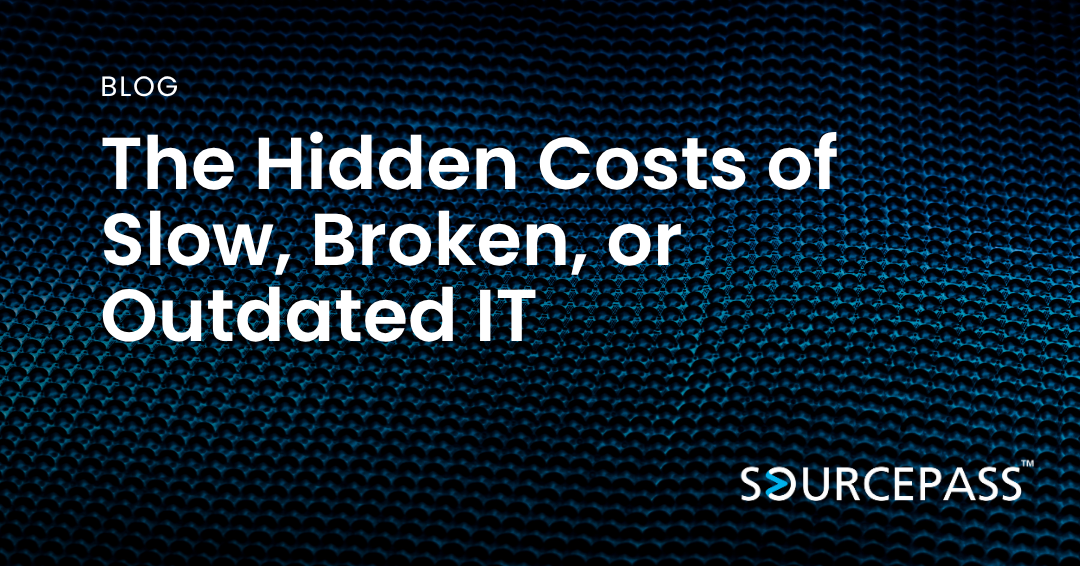The Hidden Costs of Slow, Broken, or Outdated IT
Jun 16, 2025 Admin Cloud & Infrastructure | Costs & Budget | IT Services & Support 2 min read



When business leaders think about IT problems, they often picture catastrophic outages or cybersecurity breaches. But in reality, it’s the slow, broken, or outdated technology that silently drains productivity, frustrates employees, and stalls growth—without ever making headlines.
These everyday issues rarely feel urgent enough to prioritize. But over time, they add up to a significant operational and financial burden. This article breaks down the hidden costs of bad IT and explains how to spot the warning signs before they cut deeper into your bottom line.
1. Productivity Drain: The True Cost of “Just a Few Minutes”
Outdated or sluggish systems create friction throughout the workday. Waiting on slow logins, delayed file uploads, or glitchy software may only take a few minutes each time—but when multiplied across users and weeks, those minutes become lost hours.
Real-World Impact:
- Employees waiting on systems: If 20 staff lose 10 minutes per day to IT inefficiencies, that’s over 66 hours per month.
- Cumulative annual cost: For mid-sized teams, this equates to tens of thousands of dollars in wasted wages and delayed deliverables.
2. Tech Support That Slows You Down
Inadequate or reactive IT support forces employees to work around problems or wait for resolution. Whether it’s waiting days for a helpdesk ticket or lacking clarity on who to call for help, poor support wastes time and reduces output.
Signs You’re Falling Behind:
- Long wait times for IT issues to be resolved
- Recurring tech problems without permanent fixes
- One overwhelmed internal IT person juggling too many roles
These challenges often lead to employee frustration, lower morale, and, ultimately, higher turnover—especially in remote or hybrid work environments.
3. Missed Opportunities from Outdated Tools
Many growing companies get stuck using outdated systems simply because they “still work.” But legacy technology can prevent you from adopting modern tools that improve customer experience, support automation, or enable better data analytics.
Examples:
- An architecture firm still using on-prem file servers struggles with remote collaboration.
- A consulting firm lacks the ability to automate client onboarding due to outdated CRM platforms.
- A property management team can’t scale tenant communication without integrated mobile apps.
Old tools don’t just slow down your current operations—they actively block innovation and scalability.
4. Hidden Compliance and Security Risks
Outdated software is a magnet for cybersecurity threats. Unsupported operating systems, missing patches, and legacy devices increase your risk of data breaches, which come with legal, financial, and reputational costs.
Did You Know?
- Many ransomware attacks target unpatched systems or end-of-life software.
- In regulated industries, failing to keep IT current can violate compliance standards like HIPAA, FINRA, or PCI-DSS.
You don’t need a major attack to feel the pain—just one small vulnerability can lead to fines, audits, or client trust issues.
5. Technical Debt That Gets More Expensive Over Time
Every time you delay an upgrade, ignore integration problems, or stick with quick fixes, you’re adding to your technical debt. Eventually, that debt comes due—in the form of costly migrations, data loss, or infrastructure overhauls that interrupt business.
Common Long-Term Costs:
-
Rebuilding outdated systems under time pressure
-
Paying premiums for last-minute vendor support
-
Lost data from incompatible platforms or poor backups
What seems like a cost-saving decision in the short term can result in higher expenses and longer downtime in the future.
Final Thought: If It Feels “Good Enough,” You’re Probably Losing Money
The most expensive IT problems aren’t the ones you see—they’re the ones you’ve learned to live with. Delays, workarounds, and outdated tools might not shut you down completely, but they’re still holding your business back.
Request an IT assessment today with a Sourcepass expert. We’ll help you identify performance gaps, security risks, and modernization opportunities—so you can turn your tech into a competitive advantage.
Subscribe To
Sourcepass Insights
Sourcepass Insights
Stay in the loop and never miss out on the latest updates by subscribing to our newsletter today!
.png?width=500&height=100&name=White%20Logo%20-%20Transparent%20Tag%20(3).png)



